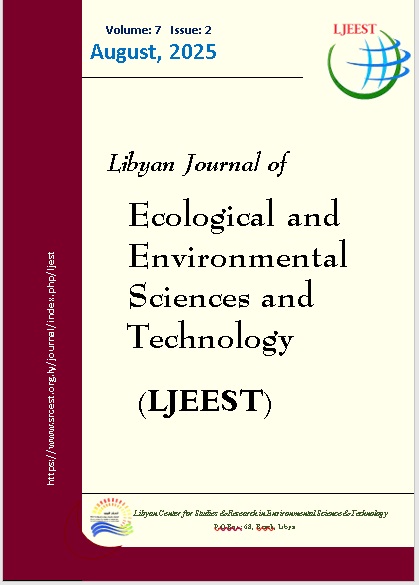National Inventory and Ecological Status of Marine Crustaceans in Libyan Waters, Southern Mediterranean
DOI:
https://doi.org/10.63359/t5fw9g85Keywords:
Checklist, Libyan coast, non-indigenous, biodiversityAbstract
The Libyan coast provides an ecological habitat supporting a diversity of marine crustaceans. This study aims to assess the diversity, spatial distribution, and ecological status of crustacean species inhabiting Libyan marine waters. Data were compiled from a comprehensive review of unpublished scientific surveys, technical reports, and biological samples collected along various parts of the Libyan coast during two main sampling periods: January 2005 to March 2006, and January 2013 to January 2017. Additional benthic samples were obtained from a shipwreck site located on a sandy seabed at a depth of 31 meters off the coast of Tripoli during both winter and summer seasons in 2020. A total of 357 crustacean species were identified, encompassing five taxonomic classes and 138 families. Species richness was highest in the eastern coastal region. The class Malacostraca represented the most taxonomically diverse group, comprising 62.32% of the identified families and 162 species (45% of the total species count). This was followed by Hexanauplia, which accounted for 31.88% of the families and included 183 species (50.83%). The majority of recorded species (94.40%) were native to Libyan waters, while 5.60% were classified as non-indigenous. These non-indigenous species, primarily localized along the coast, offer critical insights into patterns of marine bio-invasion and species establishment in the south-eastern Mediterranean Sea. This study provides a comprehensive evaluation of crustacean biodiversity along the Libyan coast, contributing significantly to baseline data for regional marine biodiversity assessments. It also highlights key distributional patterns and potential ecological implications of non-indigenous species in this underexplored sector of the Mediterranean basin.
References
Abushaala, N. M., Shaibi, T. & Howaege, H. M. 2014. The abundance and diversity of benthic crustaceans along the coastal zone of Western Libya. Journal of the Black Sea/Mediterranean Environment, 20, 33-45. https://doi.org/10.1080/00222939200770741
Anon (1966) Campagnc du "Dauphin" dans les eaux Libyannes. Bulletin de l'Institut national scientifique et technique d'océanographie et de pêcheOceanogr Peche Salambo 1(2): 43-65. https://doi.org/10.3406/estat.1966.10297
Anon, (2003) Final Report concerning the Results of the Distribution and Abundance of Demersal Fisheries Resources in Libyan Waters, Carried out by the R/V Philia, between Egyptian Border and Misurata.
Bek-Benghazi, N., Al-Mgoushi, A., Hadoud, D., and Shakman, E. (2020) Marine Mollusca of the Libyan waters, the southern Mediterranean Sea. Journal of the Black Sea/Mediterranean Environment, 26(3).
Bazairi, H., Sghaier, Y. R., Benamer, I., Langar, H., Pergent, G., Bouras, E., Verlaque, M., Soussi, J. B. & Zenetos, A. 2013. Alien marine species of Libya: first inventory and new records in El-Kouf National Park (Cyrenaica) and the neighbouring areas. Mediterranean marine science, 14, 451-462. https://doi.org/10.12681/mms.555
Contransimex, C. (1977) Final report concerning the results of the fisheries oceanographic survey, carried out by the Romanian research team on board of the vessels "Delta Dunarii" and "Gilort" in the Eastern territorial waters of the Libyan Arab Republic between Ras Azzaz and Ras Karkura. (Contransimex technical report) 2: 173-563. https://doi.org/10.1017/s0263718900008840
El Mgawshi, M. (2020) The Impact of Shipwrecks on Biodiversity and MarineEnvironment on the Tripoli Coast Libya Msc. Thesis, Libyan Academy (in Arabic).
Hadoud, D. (1999) Study of biological environmental factors in Ain El-Ghazala Lake in Libya. Msc. Thesis, Department of Zoology, Faculty of Science, University of Tripoli-Libya. 89 pp (in Arabic).
Howege, H.M. (1998) Selection of sites for aquaculture in the eastern region of Libyan coast. Unpublished technical report for Marine Biology Research Center Libya (in Arabic).
Howege, H. M. (1998) The structure of the molluscan assemblages of sea-grass beds in the Maltese Islands. Unpublished Ph. D.thesis University of Malta.370pp.
Huni, A. (1984) Study of Farwa Lagoon. Unpublished technical report for Libyan Authority for Research, Science and Technology-Libya.
Kashout, S., Hadoud, D., Elkmati, H., Ezgouzi, S. (2002) Libyan marine survey of benthic biota of economic importance (1993-1994). Food Security Conference, Tripoli, Libya.
Maccagno, T. 1939. Contributo alla conoscenza dei crostacei della Tripolitania. Bollettino dei Musei di Zoologia e di Anatomia Comparata della Reale Università di Torino, 47, 437-452.
Ortiz, M. & PETRESCU, I. 2007. The marine Amphipoda (Crustacea: Gammaridea) of the republic of Libya, southeastern mediterranean. Travaux du Muséum National d’Histoire Naturelle “Grigore Antipa, 50, 11-23.
Rawag, A. A., Haddoud, D. A. & Zgozi, S. W. 2004. Commercial demersal marine species of Libya. MedSudMed Technical Documents No, 2, 75-81.
Schram FR (1986) Crustacea. Oxford University Press, Oxford, 606 pp.
Shakman, E. A. (2008). Lessepsian migrant fish species of the coastal waters of Libya: Status, biology, ecology (Doctoral dissertation, Rostock, Univ., Diss., 2008).
Shakman, E. A., Abdalha, A. B., Talha, F., AL-Faturi, A. & Bariche, M. 2017. First records of seven marine organisms of different origins from Libya (Mediterranean Sea). BioInvasions Records, 6, 377-382. https://doi.org/10.3391/bir.2017.6.4.13
SOFIA, F. 2018. The State of World Fisheries and Aquaculture 2018-Meeting the sustainable development goals. Fisheries and Aquaculture Department, Food and Agriculture Organization of the United Nations, Rome. https://doi.org/10.18356/8d6ea4b6-en
Sogreah (1977) Trawl Fishing Ground Survey off the Tripolitanian Coast. Final Report, Sogreah, Grenoble. Part V: 1-44.
Ţiganus, V. 1984. Contributions à la connaissance de la faune associée aux macrophytes de la côte libyenne de la méditerranée. Travaux du Museum d’Histoire Naturelle, Grigore Antipa, 26, 61-68.
WoRMS Editorial Board (2020) World Register of Marine Species. http://www.marinespecies.org (accessed on 22 March 2020).
Zakhama-Sraieb, R., Yassine-Ramzi, S., Charfi-Cheikhrouha, F. (2009) Amphipod biodiversity of the Tunisian coasts: update and distributional ecology. Marine Biodiversity Records 2: e155. https://doi.org/10.1017/s1755267209990820
Zhang, Z.-Q. 2011. Phylum Arthropoda von Siebold, 1848 In: Zhang, Z.-Q.(Ed.) Animal biodiversity: An outline of higher-level classification and survey of taxonomic richness. Zootaxa, 3148, 99-103. https://doi.org/10.11646/zootaxa.3148.1.14
Downloads
Published
Issue
Section
License
Copyright (c) 2025 Libyan Journal of Ecological & Environmental Sciences and Technology

This work is licensed under a Creative Commons Attribution-NonCommercial 4.0 International License.















